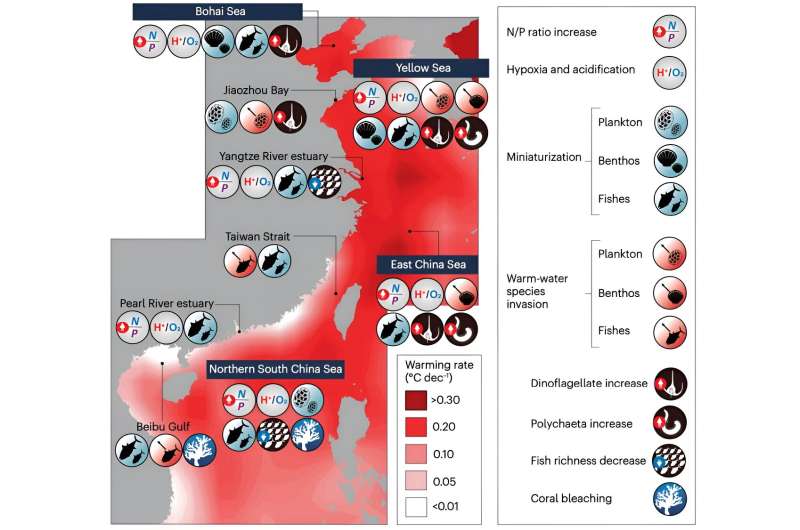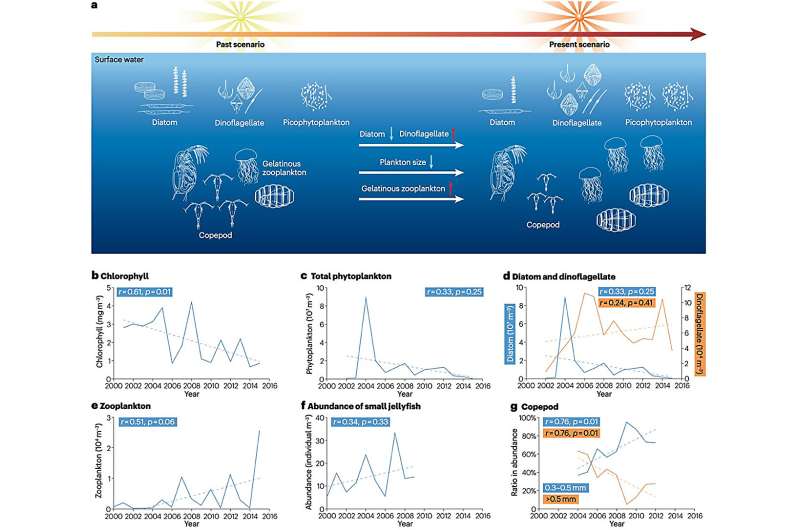This article has been reviewed according to Science X's editorial process and policies. Editors have highlighted the following attributes while ensuring the content's credibility:
fact-checked
trusted source
proofread
Study reveals how seas around China respond to warming climate

A joint research team led by Prof. Wang Fan from the Institute of Oceanology of the Chinese Academy of Sciences (IOCAS) has revealed how the seas around China respond to warming climate. The review article was published in Nature Reviews Earth & Environment on July 18.
The seas around China (SAC), including the Bohai Sea (BS), Yellow Sea (YS), East China Sea (ECS) and South China Sea (SCS), are undergoing multifaceted changes under dual effects of human activities and climate change.
The researchers synthesized scientific findings in physics, biogeochemistry, marine biology, marine ecology and other fields in recent years, and analyzed the characteristics of warming, marine heatwaves, circulation changes, eutrophication, anoxic acidification, etc.
They found that sea surface temperature (SST) warming has reached 0.10–0.14 °C per decade since 1950, and accelerated to 0.14–0.16 °C per decade since 1982, significantly faster than global average. When SST trends are strongest, it reached 0.23 ± 0.08 °C per decade since 1982, two–four times the global average. SST warming in winter is faster than that in summer owing to weakening of the East Asian winter monsoon and enhancement of warm-water intrusion from the Kuroshio. Warming trends also increase the likelihood of extreme high temperature events, marine heatwaves (MHWs).
Satellite observations since 1982 have shown that the frequency, duration, and overall intensity of MHWs in seas around China have significantly increased. These extreme events have intensively amplified the impact of climate change on seas around China, causing coral bleaching and significant losses in fisheries and aquaculture.

In the past few decades, the nascent Kuroshio has been strengthening, with a decreasing invasion into South China Sea in the upper layers and increasing in the deeper layers, as well as an increasing invasion into East China Sea and Yellow Sea. The surface anticyclone circulation in South China Sea weakened in winter due to combined effect of Kuroshio invasion and weakening of the monsoon. Circulation changes strengthened the spatial heterogeneity of warming and primary productivity changes by redistributing heat and biomass.
Terrigenous nutrient input through atmospheric deposition and river and groundwater discharges has led to pervasive trend of eutrophication, with more organic matter settling to the bottom. Warming intensifies the stratification of seawater, and degradation of organic matter in the bottom water consumes dissolved oxygen and releases carbon dioxide, resulting in increasingly severe hypoxia and acidification.
Hypoxia and acidification events in coastal seawater show a significant increasing trend of regional expansion and severity, threatening the survival and reproduction of marine organisms (especially Benthos).
In addition, the growth of phytoplankton in many sea areas has a transition from nitrogen to phosphorus limitation due to the faster growth rate of inorganic nitrogen content than that of inorganic phosphorus (the ratio of nitrogen to phosphorus increases), prompting changes in species composition of plankton communities, such as increase of dinoflagellates and decrease of diatoms. Seas around China experience a net carbon sink, contributed by carbon fixation flux, riverine and oceanic inputs, biological pump and microbial carbon pump.
"According to the latest estimate, seas around China can absorb 10.8 ± 23.1 Tg C year-1 through sea-air exchange. Although climate models predict that global warming will weaken carbon sinks in the marginal seas of the continental shelf, existing observations indicate that carbon sinks in seas around China have not significantly weakened," said Prof. Li Yuanlong, corresponding author of the study.
With changes in physical (warming, stratification strengthening, circulation planktonic, benthic, changes) and chemical (nutrient concentration and composition) backgrounds, fish communities in seas around China have also undergone significant changes, exhibiting two distinct characteristics, miniaturization and invasion of warm-water species.
The dominance of diatoms in phytoplankton community decreases, dominance of dinoflagellates increases, abundance of gelatinous zooplankton such as jellyfish increases, and the size of phytoplankton and zooplankton shows a miniaturization trend. The diversity of benthos has declined as a whole, and the distribution range, ecological habits and physiological characteristics of many benthos have changed significantly.
The synergistic effects of warming, hypoxic acidification and eutrophication on benthos are increasingly emerging. Fish show differential responses to climate change, with a significant increase in the proportion of warm-water species in seas around China.
"According to model prediction, the above change trend will continue in the future and is likely to further intensify," said Prof. Wang. "To accurately project and effectively alleviate this climate pressure, the interdisciplinary research in seas around China urgently needs to be strengthened."
More information: Fan Wang et al, The seas around China in a warming climate, Nature Reviews Earth & Environment (2023). DOI: 10.1038/s43017-023-00453-6
Provided by Chinese Academy of Sciences





















